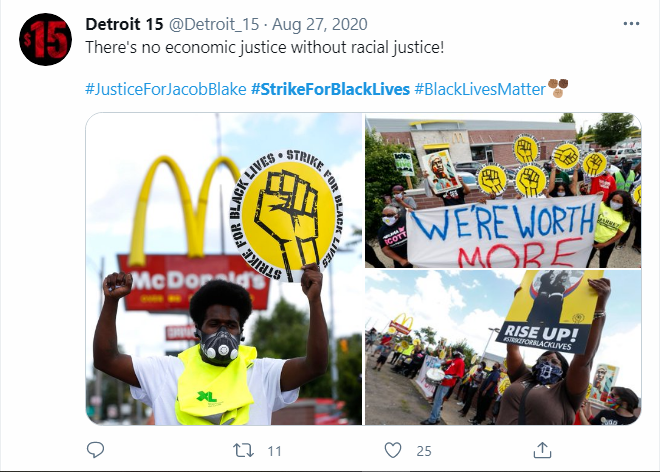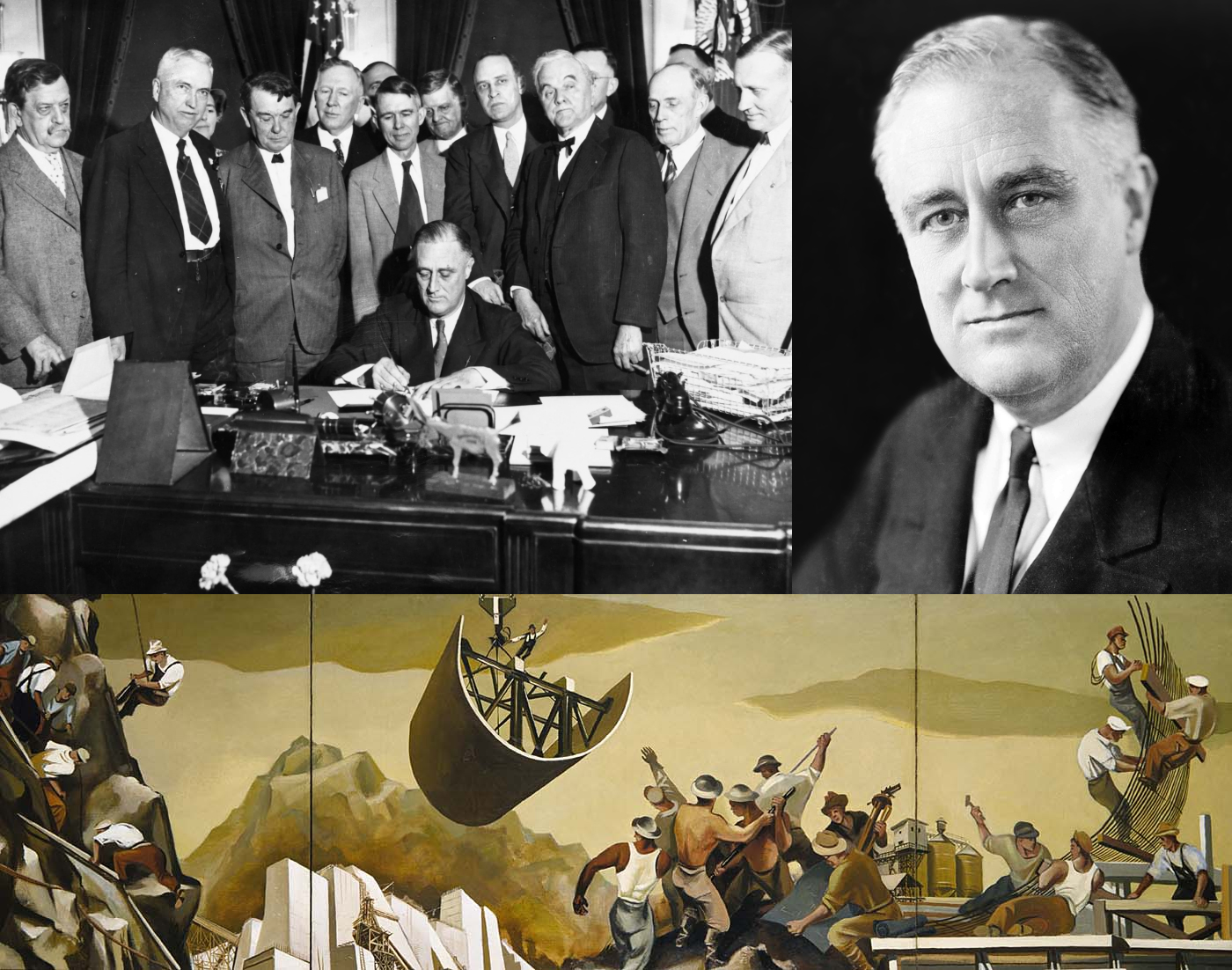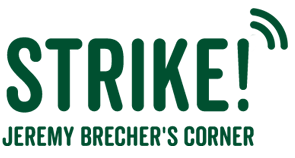Listen to the audio version >>
The fate of Biden’s “Build Back Better” proposals–and of hard-hit working people throughout the country–may depend not just on officeholders in Washington but on the action of ordinary people in response to today’s multiple crises. The previous five commentaries in this series have explored how working people have used “people power” so far in the Coronavirus Depression. This commentary reviews mass action since the start of the pandemic and compares it to the Great Depression of the 1930s. The next commentary, “The Future of People Power in the Coronavirus Depression,” looks at the role of popular action in today’s emerging economic and political landscape and suggests some guidelines for future action.

As soon as the American Rescue Plan landed in the Oval Office, President Joe Biden wasted no time signing it into effect. Read the tweet.
In the first year of the Coronavirus Pandemic and the ensuing Coronavirus Depression, “people power” played a little-acknowledged but critical role–recounted in the previous commentaries in this series–in protecting health and economic wellbeing. [1] Despite change in the national political context, they are continuing into the Biden era. Movements utilizing people power direct action may be just as important in this era. Indeed, given the sharp divisions within the system of institutionalized political power, such action may play an even more important role.
While dramatic events in Washington held national attention, the weeks following Joe Biden’s election also saw a series of “people power” actions around the country. On Martin Luther King, Jr. Day, workers in more than 15 cities struck at McDonald’s, Taco Bell, Burger King and other fast food restaurants as part of Fight for $15 and a Union.[2] Chicago teachers defied the city’s school board and refused to return to work under conditions they considered unsafe.[3] Nurses held a “day of action” with demonstrations in more than a dozen states calling for personal protective equipment, COVID testing, adequate staffing, and sick leave.[4] In Olympia, Wash., advocates for the unhoused, saying “It’s too cold for people to be sleeping on the streets, especially during a pandemic,” purchased 17 rooms in the downtown Red Lion Hotel; when homeless people from nearby encampments tried to occupy the rooms, police drove them out.[5] Workers at the Hunts Point Terminal Produce Market in New York City struck for a week, suffered police arrests while peacefully picketing, and eventually won a $1.85 an hour raise and $.40 cents an hour employer contribution for healthcare.[6]
People Power in the Coronavirus Depression

The Strike for Black Lives took place on July 20, 2020 for 8 minutes and 46 seconds. After the shooting of Jacob Blake, mobilization for Black Lives continued. Tweet from @Detroit15.
Since the outbreak of the coronavirus pandemic in early 2020, there have been many such sporadic but significant outbursts of popular self-organization and “people power” action. Unemployed organizing brought together thousands of people in on-line networks and in the streets to demand fixing of dysfunctional state unemployment systems. Wildcat strikes– reportedly over 1000 since the start of the pandemic–demanded Personal Protective Equipment, COVID-safe workplaces, and extra pay for essential workers.[7] Strikes and threats to strike by teachers throughout the country have demanded classes be held only in COVID-safe schools. Thousands participated in rent strikes and other housing actions. Fifteen million people participated in Black Lives Matter demonstrations–the largest protests in American history–and Black Lives Matter strikes were backed by some of America’s biggest unions. In December, a Los Angeles coalition brought together healthcare, labor and community organizations that represent tens of thousands of Los Angeles workers, including frontline healthcare workers, pre-K to 12th grade teachers and university educators, grocery store workers, hospitality workers, educational, housing and racial justice advocates to demand a four-week “circuit breaker” lockdown with safety nets for businesses, workers, and families so that they could safely stay home. Hundreds of thousands survived the hardships of the Coronavirus Depression through self-organized mutual aid.
Public policy has been strongly impacted by such people power action. Thousands of companies and local governments have been forced to provide Personal Protective Equipment and introduce protective public health policies. Teachers demands, strikes, and pressure tactics have played a major role in shaping both public health and educational policy, shutting down schools and determining the conditions under which they can reopen. Fight for $15 strikes encouraged many states to pass $15 minimum wage legislation and helped lead the Biden Administration to include a $15 minimum wage as part of its American Rescue bill.
These actions provide an essential background for understanding the surprising start of Joe Biden’s presidency. This conservative, pro-corporate politician known for his opposition to healthcare for all has been described–with only modest exaggeration–as taking more progressive action in his first eight days in office than Barack Obama did in his whole eight years. He has identified the great crises of our time: climate, pandemic, economic hardship, white supremacy, and now the crisis of democracy. He has pledged his “Build Back Better” program will address them. Maybe he had a vision on the road to Damascus – but more likely he is responding to the pressures from below manifested not only in electoral action but in campaigns for COVID protection, strikes and strike threats, Black Lives Matter demonstrations, and teacher and community protests for school safety. His future trajectory is likewise likely to be shaped in part by the strength of such pressures from below.
At the start of 2021, as political power appears poised between Dr. No Republicans and Democrats divided on whether to push for change or a return to “normalcy,” people power may make a critical difference in how we address the multiple crises of climate, pandemic, economic depression, white supremacy, and democracy. Beyond that, it can help lay the groundwork for deeper reforms and a more far reaching Green New Deal.
The history of the original New Deal offers some hints of how this could happen.
People Power in the Great Depression

Top left: The Tennessee Valley Authority, part of the New Deal, being signed into law in 1933. Top right: FDR (President Franklin Delano Roosevelt) was responsible for the New Deal. Bottom: A public mural from one of the artists employed by the New Deal’s WPA program. Upload date: Jan. 11, 2008. Author: LordHarris, English Wikipedia.
In the early days of the Great Depression of the 1930s, hundreds of thousands of people participated in hunger marches, unemployed organizations, various forms of self-help mutual aid, street protests, anti-eviction actions, “Farm holiday” blockades, strikes, and occupations of city halls and state capitals. Their purpose was to force local, state, and federal governments and elites to address the needs of those hit by economic catastrophe. Their role was critical both before and after the 1932 elections that led to Democratic political control and the proclamation of the New Deal. It helped lay the groundwork for the greatest period of social reform since the Civil War and the greatest period of worker organization ever.
Franklin D. Roosevelt entered the presidency as a fiscal conservative pledged to balance the budget with no specific plan to counter the Great Depression. His New Deal began as a program of reform oriented more toward saving American business than to rescuing its people. Among his first acts were to cut government salaries and veterans’ benefits. But unemployed and worker movements continued to force local, state, and national governments to address hardship and enormously expand relief. Pressure from below–from the likes of the unemployed, workers, and farmers–had already turned a silent emergency into a threat to the status quo. Roosevelt responded with a series of emergency relief measures designed to limit hardship, protest, and the downward spiral of depression.
The New Deal era represented a historic realignment in American politics as urban ethnic groups, rural communities, African Americans, workers, and others hard hit by the Great Depression flooded into the Democratic Party, creating what came to be known as the New Deal Coalition. But direct action from below was a significant factor in many of the major initiatives of the early New Deal. The threat of action by the unemployed laid the groundwork for emergency programs like the Federal Emergency Relief Administration (FERA), the Civilian Conservation Corps (CCC), and the Works Progress Administration (WPA). The Farm Holiday movement helped call forth the Agricultural Adjustment Act (AAA).
But the effect of pressure from below didn’t stop there. The unemployed, union organizing, strike, and old-age pension movements–combined with the mass movements led by demagogic populist leaders like Louisiana governor Huey Long and radio priest Father Charles Coughlin–led Roosevelt in 1935-6 to opt for a cascade of more radical programs often referred to by historians as the “Second New Deal.” The old-age pension movement led by Dr. Francis Townsend and the labor and unemployed campaign for the Workers’ Unemployment Insurance bill (Lundeen bill) laid the groundwork for Social Security. The 1934 strikes and general strikes created the pressures that led to the Wagner Act and the growth of industrial unionism. Roosevelt successfully backed passage of the modest Wealth Tax Act of 1935 to steal the thunder of the Share Our Wealth progressive taxation movement backed by Huey Long. Mass mobilization by workers and the unemployed helped save Social Security from gutting by Republicans in Congress. It also helped limit the power and appeal of white supremacist, right-wing, and fascist movements that repeatedly threatened to erupt into national prominence.
The period of dramatic New Deal reforms was short-lived. In 1936 the Supreme Court began declaring major New Deal programs unconstitutional. Starting in 1937 a conservative coalition in Congress between Republicans and Southern Democratic “Dixiecrats” put an end to passage of New Deal legislation. While many of their demands were met or deflected, mass movements–above all the burgeoning labor movement–continued to use people power to address the needs of those at the bottom.
In the stories I heard in my youth from old New Dealers there were often two set of enemies. One were the right-wingers–most of the Republican Party, the Liberty Leaguers, anti-labor corporations, HUAC, the FBI, and racists and anti-Semites of many kinds. But there was another set of enemies–the New Deal coalition’s “enemies within.” They included the Herbert Hoover-initiated Reconstruction Finance Corporation, Roosevelt-backed J. Edgar Hoover, and the Southern white supremacists in the Democratic Party. In the argot of the day they were often referred to as “phony” New Dealers–opportunistically hiding under the popular mantle of the Roosevelt Administration while actually striving to undermine its most progressive policies and supporters. Roosevelt was the arbiter and at the same time the target of these struggles within the New Deal coalition. He was also complicit with some of the most reactionary policies promulgated in the name of the New Deal, notably those promoted by racist Southern senators and congressmen.
In a period of reform there may also be corporate and other powerful forces which want to support some aspects of a reform program. They may do so from fear of more radical challenge or of social chaos; from recognition of major social problems that threaten the whole society; or from specific gains that may be made by an individual company or sector. In the 1930s some elites supported federal relief programs because they feared riot and even revolution. Many supported the National Recovery Administration (NRA) because they felt something was necessary to combat the Great Depression. Some companies–for example General Electric–supported expanded labor rights because they would give their large, technologically-advanced companies an advantage over their smaller, technologically-backward competition. (Similarly, today some sectors of business support some parts of Biden’s reform program. The U.S. Chamber of Commerce applauded the Biden Rescue plan–but said it shouldn’t last too long.) The New Deal program would never have been passed and implemented without such support. But dependence on such forces also puts a limit to how far reforms can go. It can be tough to know when to cooperate with such forces and when to fight them, but both are likely to be necessary.
Conclusion
Within such a complex arena of struggle, action by those affected by hardship shows the public, the media, and politicians that public response is essential and urgent. It is easy to ignore a million hungry people, but it is not easy to ignore a million hungry people who are pressing their demands at government offices and in the streets.
Such action demonstrates to politicians that there are needy constituencies that can be appealed to–and if one politician or political force doesn’t appeal to them, their competitors may do so. As one old New Dealer told me regarding the second New Deal, Roosevelt had to keep out front in the fight for social progress or people would quickly look for other leaders–like Huey Long and Father Coughlin. That same dynamic might apply in the era of the Coronavirus Depression.
The next commentary in this series, “The Future of People Power in the Coronavirus Depression,” will look more deeply into the strategic issues facing people power actions in the Biden era.
[1] Strike! Commentaries on Solidarity and Survival
[2] Chauncey Alcorn, “Fast food workers go on strike in honor of Martin Luther King Jr.,” CNN Business, KCTV 5, January 15, 2021.
[3] Sophia Tareen, “Chicago teachers vote to teach from home, defying district,” The Associated Press, January 24, 2021.
[4] Ian Prasad Philbrick and Reed Abelson, “Health Care Unions Find a Voice in the Pandemic,” The New York Times, updated January 29, 2021.
[5] Alta Spells, “Olympia, Washington police clear out hotel after it was ‘occupied’ by homeless activist group, city says,” CNN US, February 1, 2021.
[6] Edward Ongweso Jr, “Cops Arrest Essential Union Workers Striking for $1 Raise,” Vice, January 19, 2021.
And “End of week-long strike: New York: Hunts Point market workers agree with negotiations,” Hortidaily, February 4, 2021.
[7] Estimates vary depending on the definition of strikes. See Chris Brooks, “Fact Check: Have there been 500 wildcat strikes in June?” Organizing Work, June 23, 2020 and references there.

